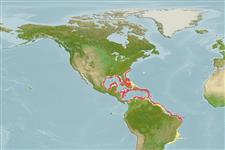>
Eupercaria/misc (Various families in series Eupercaria) >
Lutjanidae (Snappers) > Etelinae
Etymology: Etelis: Greek, etelis, -idos = a fish, perhaps the fish Sparus aurata (Ref. 45335).
More on author: Valenciennes.
Environment: milieu / climate zone / profondeur / distribution range
Écologie
marin bathydémersal; profondeur 100 - 450 m (Ref. 9626). Deep-water; 37°N - 25°S, 8°E - 32°W
Western Atlantic: Bermuda and North Carolina, USA, Gulf of Mexico southward through the Caribbean to Sau Paulo, Brazil (Ref. 55), including the Fernando do Noronha and Atol das Rocas Islands (Ref. 113956).
Length at first maturity / Taille / Poids / Âge
Maturité: Lm 31.0, range 35 - ? cm
Max length : 100.0 cm TL mâle / non sexé; (Ref. 9626); common length : 64.0 cm TL mâle / non sexé; (Ref. 6912); poids max. publié: 6.3 kg (Ref. 56081)
Épines dorsales (Total) : 10; Rayons mous dorsaux (Total) : 11; Épines anales: 3; Rayons mous anaux: 8. Head small; eye large; snout short. Maxilla covered with small scales; lower jaw slightly projecting. Dorsal and anal fin bases without scales; caudal fin deeply forked. Scale rows on the back running parallel with the lateral line. Back and upper sides deep pink to red; lower sides and belly pink; fins pink except the spinous portion of the dorsal fin; entire caudal fin brilliant red.
Body shape (shape guide): fusiform / normal; Cross section: oval.
Adults inhabit rocky bottoms and feeds mainly on small fishes and squids. They are abundant near oceanic islands (Ref. 9626). Small individuals are taken as by-catch in trawl fisheries (Ref. 5217). Marketed mostly fresh, sometimes frozen. Flesh of good quality.
Life cycle and mating behavior
Maturité | Reproduction | Frai | Œufs | Fécondité | Larves
Allen, G.R., 1985. FAO Species Catalogue. Vol. 6. Snappers of the world. An annotated and illustrated catalogue of lutjanid species known to date. FAO Fish. Synop. 125(6):208 p. Rome: FAO. (Ref. 55)
Statut dans la liste rouge de l'IUCN (Ref. 130435: Version 2025-1)
Menace pour l'homme
Harmless
Utilisations par l'homme
Pêcheries: commercial; pêche sportive: oui
Outils
Articles particuliers
Télécharger en XML
Sources Internet
Estimates based on models
Preferred temperature (Réf.
123201): 13.3 - 22.7, mean 18.3 °C (based on 73 cells).
Phylogenetic diversity index (Réf.
82804): PD
50 = 0.5312 [Uniqueness, from 0.5 = low to 2.0 = high].
Bayesian length-weight: a=0.01698 (0.01382 - 0.02086), b=2.93 (2.87 - 2.99), in cm total length, based on LWR estimates for this species (Ref.
93245).
Niveau trophique (Réf.
69278): 4.2 ±0.57 se; based on food items.
Generation time: 3.8 ( na - na) years. Estimated as median ln(3)/K based on 2
growth studies.
Résilience (Réf.
120179): Milieu, temps minimum de doublement de population : 1,4 à 4,4 années (K=0.29-0.61).
Prior r = 0.24, 95% CL = 0.16 - 0.36, Based on 1 data-limited stock assessment.
Fishing Vulnerability (Ref.
59153): Low to moderate vulnerability (34 of 100).
🛈
Nutrients (Ref.
124155): Calcium = 20.6 [8.4, 56.2] mg/100g; Iron = 0.501 [0.218, 1.134] mg/100g; Protein = 18.2 [16.1, 20.1] %; Omega3 = 0.387 [0.185, 0.742] g/100g; Selenium = 21.5 [8.7, 53.3] μg/100g; VitaminA = 7.31 [1.36, 42.54] μg/100g; Zinc = 0.252 [0.166, 0.397] mg/100g (wet weight);
